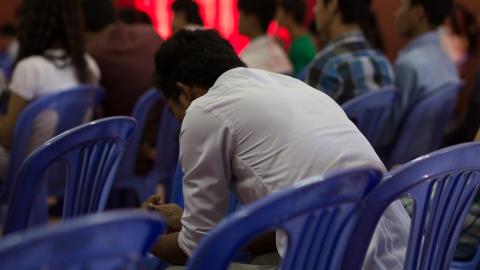The Posture of Prayer

Editor’s Note: In forming Resonate Global Mission, Resonate staff developed six core postures that are essential for effective mission work in and through the Christian Reformed Church. While the postures can stand alone, we’ve asked staff around the globe to give them some substance by sharing examples from their own experiences on the mission field.
This first post focuses on the posture of Prayer and is co-written by Resonate’s Joyce Suh in Cambodia and another Resonate staff member in the Middle East.
“But Jesus often withdrew to lonely places and prayed." Luke 5:16
This short verse tells us that Jesus’ ministry of word and action among the crowds, disciples, and religious establishment was centered around his posture of prayer. Jesus often went to be alone to pray — needing rest and refreshment from perpetually pleasing those around him, and truly enjoying these moments with his Father. Think about it. The very son of God, filled with the Holy Spirit, yet Jesus’ mission would not have been as transformational without prayer.
Jesus opened the door for us to follow him into this posture of prayer, especially in the difficult and diverse contexts where we serve as leaders, partners, and servants in ministry. A posture of prayer means a life of prayer. Whatever form this may take in our lives, this posture will bring our most powerful contributions to our mission in God's kingdom.
Prayer allows us to acknowledge God's work before we even begin to plan our goals for mission work and helps us be open to how He wants to use us to accomplish his work. Prayer means withdrawing ourselves from a hectic schedule to holy ground — looking for God, presenting our circumstances to him, requesting his presence and power, and recognizing him in every detail of our lives at any moment of our lives.
A posture of prayer is about our internal transformation as much as it is about an external transformation of the world around us. It’s an ability to see God's will and God's work, and to ready ourselves to cooperate and call others into communion with the Holy Spirit. Prayer helps us recognize God's mission in every element of the world around us — from the places where evil presses in, to the glories of creation.
So what does prayer look like on our mission field? We meet with Chan (not his real name), a young Cambodian drug addict who wants to know Jesus but who is caught in a cycle of addiction. We pray with him, for restraint of the evil that is at work in his life. We make it a habit to pray for him in our family devotion time. We receive a cry for help by phone text. We pray to God to help us discern the ways in which we can help and the things that we must leave to God and to others. We invite prayer from others, creating and entering a circle of prayer. After hearing of a relapse (again), we cling together to God and lament the brokenness of the situation.
Whether God has called you to serve in your local context or in a cross-cultural mission field like Cambodia, you’ll likely find prayer to be both life-giving and difficult. This posture may feel unnatural at the beginning and during stressful times. But, like something we have become accustomed to in the culture we live in, a culture of prayer takes on a momentum. Effortful and effortless, the posture of prayer is essential for our effectiveness.
Global Mission, Faith Practices
Church Renewal, Global Mission
Global Mission, Biblical Justice
Connect to The Network and add your own question, blog, resource, or job.
Add Your Post
Let's Discuss
We love your comments! Thank you for helping us uphold the Community Guidelines to make this an encouraging and respectful community for everyone.